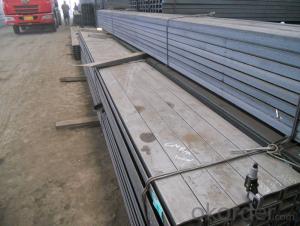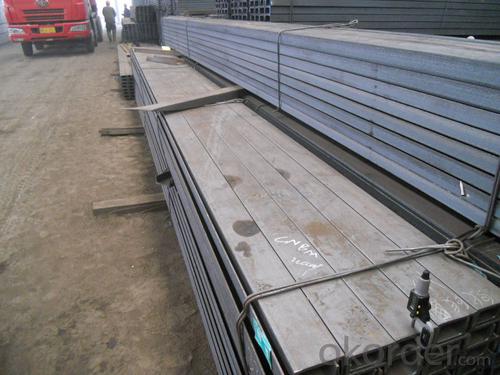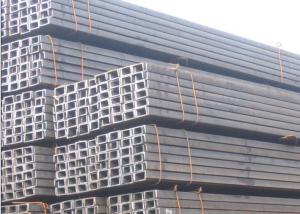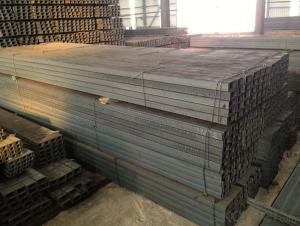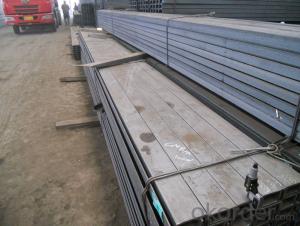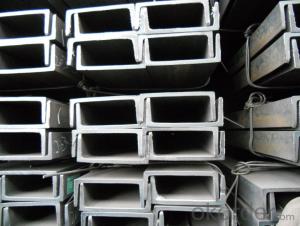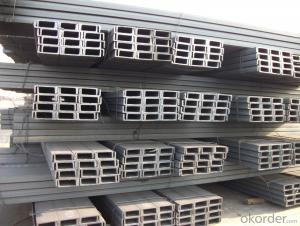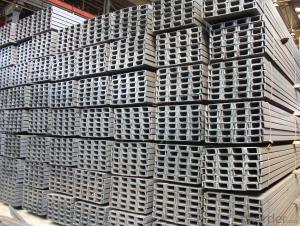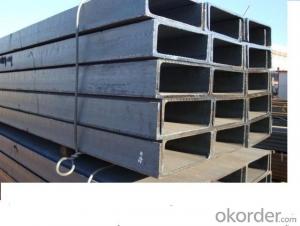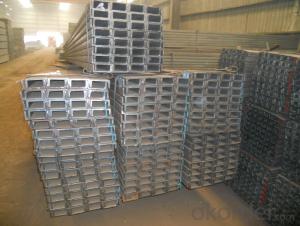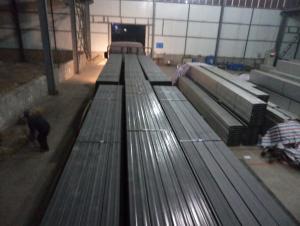High Quality 22# Steel Channel
- Loading Port:
- China Main Port
- Payment Terms:
- TT OR LC
- Min Order Qty:
- -
- Supply Capability:
- -
OKorder Service Pledge
OKorder Financial Service
You Might Also Like
Steel Channel
Standard: GB
Material: Q235
Length: 6m, 12m
Size:
| Size (mm) | Mass (Kg/m) |
| 220*77*7.0 | 24.999 |
| 220*79*9.0 | 28.453 |
The chemical composition of HR Channel Steel according to Q235B is shown in Table-1.
Alloy No | Grade | Element(%) | ||||
C | Mn | S | P | Si | ||
Q235 | B | 0.12-0.20 | 0.3-0.7 | ≦0.045 | ≦0.045 | ≦0.3 |
Table-1
Note: we are able to present our customers relevant SGS test report for chemical composition of HR Channel Steel.
The mechanical property of HR Channel Steel according to Q235B is shown in Table-2
Alloy No | Grade | Yielding Strength Point(Mpa) | |||
Thickness(mm) | |||||
≦16 | >16-40 | >40-60 | >60-100 | ||
≧ | |||||
Q235 | B | 235 | 225 | 215 | 205 |
Table-2
Package & Delivery of Channel:
1.The hot rolled channel steel will be packed in bundle with steel wire at each end of every bundle and color marking in order to help the customer to recognize his goods more easily at sight.
2. And the hot rolled channel steel could be loaded into 20ft or 40ft container, or by bulk cargo.If the weight of each bundle reaches more than 3.5 mt, the loading by break bulk cargo should be choosed.When the weight of each bundle reaches less than 3mt, the loading by container should be choosed.
3.As for the transportaion from mill to loading port, the truck will be usually used. And the maximum quantity for each truck is 40mt.
4.All in all, we could do in accordance with customer's request.
*If you would like to get our price, please inform us the size, standard/material and quantity. Thank you very much for your attention.
- Q: Can steel channels be used for fencing purposes?
- Indeed, steel channels possess the ability to serve as fencing components. With their versatility and strength, steel channels prove to be an exceptional option for fencing purposes. They allow for the creation of robust and enduring fence structures capable of enduring diverse weather conditions and ensuring security. Furthermore, steel channels offer ease of customization to accommodate various fencing designs and sizes, and they can be seamlessly integrated with other materials such as wire mesh or panels to enhance both security and visual appeal. Moreover, their resistance to corrosion guarantees a lasting solution for fencing projects.
- Q: Is the track steel often called channel or construction steel?
- Rectangular steel can be used as upright post. The crossbeam and so on, characteristic is starts the thing quickly. (it is faster to weld than two to channel steel)If the bridge, house, girder, anyway, from the top down is pressed by I-beam, the most rational rail steel and general construction steel different, but I type strong forceRail steel is a high strength alloy steel. The requirements are strict and the properties are different
- Q: What are the different loadings that steel channels can withstand?
- Steel channels can withstand a wide range of loadings, making them a versatile and reliable structural component. The specific loadings that steel channels can withstand depend on various factors, including the type and grade of steel, the size and shape of the channel, and the design of the overall structure. Steel channels are commonly used in construction and engineering applications to provide support and stability. They can withstand both static and dynamic loadings, which include dead loads, live loads, and environmental loads. Dead loads refer to the weight of the structure itself, including the weight of the steel channels and any other components or materials. Steel channels are designed to bear this constant load without deformation or failure. Live loads are temporary loads that can vary in magnitude and location. These loads include the weight of people, furniture, equipment, and other transient forces. Steel channels are designed to support these loads and distribute them effectively to other structural members. Environmental loads include wind loads, snow loads, and seismic loads. Steel channels are designed to resist these external forces and maintain the structural integrity of the building or structure. Wind loads can exert significant pressure on the channels, especially on tall or exposed structures. Snow loads can accumulate and add weight to the structure, which the steel channels must be able to support. Seismic loads refer to the forces generated during an earthquake, and steel channels are designed to withstand these dynamic loads and prevent the structure from collapsing. In addition to these common loadings, steel channels can also withstand other specialized loadings, such as impact loads, vibration loads, and thermal loads. Impact loads can occur due to accidental collisions or sudden impact events and require steel channels to have high strength and toughness. Vibration loads can result from machinery or equipment operation and require steel channels to have good fatigue resistance. Thermal loads can cause expansion and contraction of the steel channels due to temperature changes, and they must be designed accordingly to prevent failure. Overall, steel channels have a high load-bearing capacity and can withstand a wide range of loadings, making them suitable for various structural applications in construction, engineering, and industrial sectors.
- Q: Can steel channels be used for creating overhead support structures?
- Yes, steel channels can be used for creating overhead support structures. Steel channels are commonly used in construction for their high strength and durability. They provide a stable and reliable framework for overhead support structures, such as beams and trusses, ensuring the safe and secure support of the load above.
- Q: Can steel channels be customized to specific dimensions?
- Certainly, specific dimensions can be achieved when customizing steel channels. Steel channels possess versatility, allowing them to be tailored to meet specific width, height, and thickness requirements. This customization is accomplished through a range of manufacturing techniques such as cutting, bending, and welding. By modifying these dimensions, steel channels can be perfectly suited to fit particular applications and structural necessities. Whether it be for construction, machinery, or any other industry, steel channels offer the flexibility to meet desired dimensions and specifications when customized.
- Q: Can steel channels be used for railway tracks?
- No, steel channels cannot be used for railway tracks. Railway tracks require a specific type of steel called "rail steel" or "railroad steel" that is specifically designed and manufactured for the purpose of constructing railway tracks. Rail steel has certain properties that make it suitable for withstanding the heavy loads, constant stress, and wear and tear that railway tracks face. It has a specific chemical composition and is made through a specialized manufacturing process to ensure its durability and strength. Steel channels, on the other hand, are not designed to withstand the same level of stress and wear as rail steel and would quickly deteriorate under the heavy loads and constant movement of trains. Therefore, it is essential to use rail steel for constructing railway tracks to ensure the safety and efficiency of the rail system.
- Q: Are steel channels suitable for use in bridges?
- Yes, steel channels are suitable for use in bridges. Steel channels offer several advantages that make them a popular choice for bridge construction. Firstly, steel channels are known for their high strength-to-weight ratio, which allows for the construction of lightweight yet durable bridges. This is particularly important in areas with limitations on the weight that can be supported by the ground or existing infrastructure. Additionally, steel channels provide excellent resistance to corrosion. Bridges are often exposed to harsh environmental conditions, such as rain, snow, and moisture, which can cause deterioration of the materials used. Steel channels are typically made from corrosion-resistant alloys or are coated with protective layers, making them highly durable and ensuring the longevity of the bridge structure. Furthermore, steel channels offer versatility in design and fabrication. They can be easily shaped, cut, and welded to meet specific project requirements, allowing for the creation of intricate bridge designs. Steel channels also provide the flexibility to adapt to different load-bearing capacities, enabling engineers to construct bridges that can accommodate varying traffic volumes and weights. Lastly, steel channels have a long history of successful use in bridge construction. They have been extensively tested and proven to withstand heavy loads, extreme weather conditions, and provide long-term structural integrity. In conclusion, steel channels are a suitable choice for use in bridges due to their high strength-to-weight ratio, resistance to corrosion, versatility in design, and proven track record of performance.
- Q: How do steel channels contribute to sustainable design?
- There are several ways in which steel channels contribute to sustainable design. To begin with, steel channels are manufactured using recycled materials. Steel is widely recognized as one of the most recycled materials globally, with a substantial proportion of steel production coming from recycled scrap. This practice decreases the demand for raw materials and diminishes energy consumption during the manufacturing process, ultimately resulting in a reduced carbon footprint. Moreover, steel channels possess a remarkable lifespan. Due to its exceptional durability, steel can withstand harsh weather conditions and resist corrosion effectively. Consequently, steel channels necessitate minimal maintenance and replacement over time, thereby reducing the frequency of repairs and replacements. This not only conserves valuable resources but also minimizes the construction and demolition waste generated. In addition, steel channels are characterized by their lightweight nature and versatility. These qualities allow for efficient transportation and installation, which, in turn, decreases fuel consumption and associated emissions. Additionally, the versatility of steel channels enables them to be easily repurposed or reused in other projects, extending their lifespan and minimizing waste. Furthermore, steel channels provide design flexibility. The strength and structural integrity of steel enable the implementation of innovative and efficient designs, such as open floor plans and large spans. These designs maximize natural lighting and ventilation, reducing the reliance on artificial lighting, heating, and cooling systems. Consequently, energy consumption is lowered, and greenhouse gas emissions are reduced. Lastly, at the end of their lifespan, steel channels can be recycled. Steel is entirely recyclable, allowing it to be reused indefinitely without any loss of quality. This not only conserves natural resources but also reduces the amount of waste that ends up in landfills. In conclusion, steel channels significantly contribute to sustainable design through their utilization of recycled materials, long lifespan, lightweight and versatile nature, design flexibility, and recyclability. By incorporating these features, construction projects can minimize their environmental impact and promote the development of a more sustainable built environment.
- Q: What are the different finishing techniques for steel channels?
- There are several different finishing techniques that can be used on steel channels to enhance their appearance and protect them from corrosion. One common finishing technique is galvanizing. This involves coating the steel channels with a thin layer of zinc, which provides excellent corrosion resistance. The zinc coating can be applied through either hot-dip galvanizing, where the channels are immersed in a bath of molten zinc, or through electroplating, where an electric current is used to deposit the zinc onto the surface of the channels. Galvanized steel channels have a distinctive silver-gray appearance. Another finishing technique is powder coating. This involves applying a dry powder to the steel channels and then baking it in an oven to create a durable and decorative finish. Powder coating is available in a wide range of colors and can provide a smooth and even coating on the channels. Painting is another common finishing technique for steel channels. This involves applying a liquid paint to the surface of the channels. The paint can be applied through various methods such as brushing, spraying, or dipping. Painting not only enhances the appearance of the channels but also provides a protective barrier against corrosion. In addition to these techniques, steel channels can also be polished or brushed to create a smooth and shiny surface. Polishing involves using abrasive materials to remove any imperfections and create a reflective surface. Brushing, on the other hand, involves using a wire brush or abrasive pad to create a textured finish on the surface of the channels. Overall, there are several different finishing techniques available for steel channels, each with its own advantages and aesthetic appeal. The choice of finishing technique will depend on factors such as the desired appearance, corrosion resistance requirements, and cost considerations.
- Q: What is the minimum size of channel steel?
- Channel 5# channel, width of 50 mm, 37 mm high leg, thickness 4.5 mm.
Send your message to us
High Quality 22# Steel Channel
- Loading Port:
- China Main Port
- Payment Terms:
- TT OR LC
- Min Order Qty:
- -
- Supply Capability:
- -
OKorder Service Pledge
OKorder Financial Service
Similar products
Hot products
Hot Searches
Related keywords
